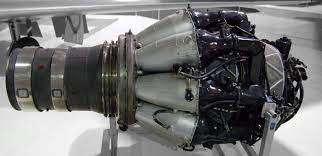Rolls Royce Derwent
 Click on image for larger version
Click on image for larger version The Rolls-Royce Derwent was an engine consisting of a centrifugal compressor with an axial flow power turbine, and was the second Rolls Royce gas turbine engine to be produced.
It was a development of the Rolls Royce Welland, the first Gloster Meteor engine that was basically Frank Whittle's Power Jets W.2B reverse flow engine that powered the Gloster E28/39 aircraft in Britain's first turbine powered aircraft to fly on May 5, 1941.
The Rover company selected to produce Whittle's engine for the Gloster Meteor continued development work on the W.2B engine, now designated W.2B/23, and started design work on a new engine designated W.2B/26, but soon fell behind on scheduled progress and in 1943 Rolls Royce took over the gas turbine design and development, and the W.2B/23 now named Derwent Mk1, was ready for operational use in 1944 with a thrust rating of 2,000lbs, increasing to 2,400lbs in the three subsequent variants.
The W.2B/26 was the basis for an engine with a thrust rating of 5,000lbs and named Nene, but it's diameter was such that it could not be installed in the Meteor engine nacelles so a scaled down variant, named the Derwent Mk5 was produced with a thrust rating of 3,500lbs. This engine powered the Meteor Mk 4 that raised the world airspeed record to 606mph on November 7, 1945 and later powered the Meteor Mk 8 aircraft. 9,700+units were built before production ceased in 1954.
|
TECHNICAL DATA- Derwent Mk 1 Type Length Diameter Dry weight Compressor Combusters Power turbine Oil system Maximum thrust Pressure ratio Thrust to weight ratio |
Centrifugal flow turbojet engine 84in (2,134mm) 43in (1,092mm) 975lbs (442kg) Single stage, double sided centrifugal 10 combuster tubes Single stage - axial flow Pressure with dry sump and scavange 2,000lbs @ sea level 3.9/1 2.04 lbs/1 |
